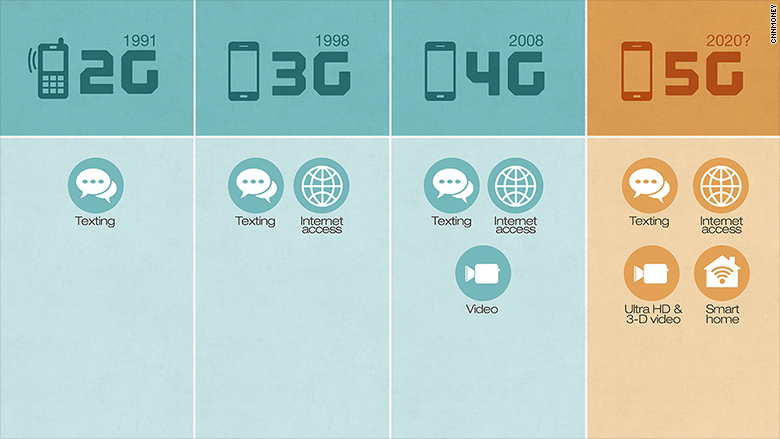
What will a world with 5G look like?
Your smartphone will have a faster connection, for sure. But that just scratches the surface of what 5G could be capable of.
Everyone in the wireless industry agrees that 5G is coming by the end of the decade. But what will it be used for? That's still up in the air.
Nokia on Tuesday previewed a demonstration it plans to present at Mobile World Congress later this month, detailing its vision for 5G. Nokia's 5G forecast includes some surprising capabilities: 5G will make cars safer to drive. It will make instant replay more instant. And doctors will be able to perform surgery using wirelessly controlled robots..
And, yes, 5G will be much faster.
Faster speeds
Nokia (NOK), aiming to be one of the world's biggest 5G players, claims that it has tested a 5G connection with download speeds of 30 gigabits per second. That's more than 1,000 times faster than your average 4G connection.
In the real world, there's very little chance of your phone actually getting speeds that fast. Trees, buildings, your distance from a cell tower and those pesky other customers who are also trying to use the network are going to slow down speeds dramatically from what Nokia was able to achieve in a lab.
Still, the wireless industry thinks 5G will be really fast: 10 to 100 times faster than 4G, according to Brian Daly, director of government standards at AT&T. Daly was speaking at a panel on 5G wireless technologies held by the CTIA wireless association in Washington on Tuesday.
Those faster speeds will also allow more customers to be connected at the same time, giving the network more capacity and making connections more reliable for mobile customers.

Video multi-casting
Sports stadiums are equipped with giant screens for people in the nosebleed sections. But what if you could get the feed of the game or concert in real-time on your smartphone or tablet? You could even switch the camera angle and get truly instant replay. And the video would be in stunning 4K, about four-times the resolution of HD.
That will all be possible with a 5G network, Nokia believes.
Self-driving cars
Today's self-driving test cars are powered by wireless networks. One problem that has emerged is the amount of latency, or lag, between the car's sensor and the data center sending information to the car.
When self-drivng cars become a reality, they'll have to identify an obstacle and immediately communicate that to the data center (and receive instructions from the cloud) with virtually no latency whatsoever. Otherwise, the car could crash.
One of 5G's biggest promises is ultra-low latency, delivering uninterrupted communication flow to driverless cars. That could dramatically improve vehicle safety and reduce congestion.
Networked robots
Robotic surgical tools can be incredibly useful machines for doctors. But they need to react in real-time, just as the doctor issues a command. The same goes for robots that perform complex manufacturing commands, which need to communicate instantly with other robots on the assembly line.
5G's low latency should help tremendously to allow networked robots to perform even more complicated tasks in the future, Nokia predicts.
Virtual reality
When you put on a virtual reality mask, you can "enter" a virtual world with other people. You can interact with them, play video games with them, and even virtually high-five them.
With 5G, Nokia believes virtual reality users "will be able to collaborate as if they are in the same physical location." It could usher in a new era of video games and remote collaboration.
"5G will give birth to the next phase of human possibilities, bringing about the automation of everything," said Marcus Weldon, chief technology officer at Nokia. "This automation, driven by a smart, invisible network, will create new businesses, give rise to new services and, ultimately, free up more time for people."

